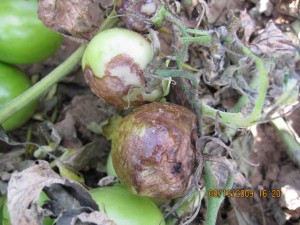Eric Draper, OSU Extension Geauga County Extension Educator, called me today to report late blight on two tomato farms in western Trumbull County, OH. Cool nights and rainy conditions are very favorable for the development of late blight. Once you have seen late blight a few times it is usually pretty easy to recognize, since the symptoms are quite distinct. Leaf lesions appear soon after infection (Figure 1A, 1B), with a dead center and a fuzzy white white border visible on the underside of the leaf. The fuzzy material contains the sporangia that can be blown in the air or splashed in water to other parts of the plant or to new plants.

Figure 1A. Late blight lesion on tomato leaf (top). Late blight is caused by Phytophthora infestans.

Figure 1B. Late blight lesion – underside of leaf. The white fuzzy border of the lesions contains sporangia of the pathogen.
Stem lesions are dark brown to black (Figure 2), and diseased fruit appear coppery in color (Figure 3), often with what appears like a dusting of white material. This white material also contains the sporangia that spread the disease.
It is very important that both potatoes and tomatoes be scouted regularly (at least twice per week) for late blight. If late blight is suspected, it can be confirmed by bringing or sending a sample to the OSU Vegetable Pathology Lab in Wooster or the OSU C. Wayne Ellett Plant and Pest Diagnostic Clinic in Reynoldsburg. We appreciate hearing from you if late blight is suspected so that we can confirm and alert others.
Growers need to maintain an effective fungicide program on tomatoes and potatoes. This should continue as long as rainy conditions, high humidity and/or heavy dews are expected. If late blight has not been observed and weather conditions are generally dry and warm, use a protectant fungicide on a 7-10 day schedule, depending on how fast the plants are growing. Good protectants are chlorothalanil (Bravo, Equus, Echo), mancozeb (Penncozeb, Manzate, Dithane), and to a lesser extent, copper-based products – use according to label instructions. Under cool wet conditions when late blight is likely, or if late blight has been found on the farm, use one of the following, tank mixed with one of the above protectants: Curzate (3 day PHI), Gavel (5 day PHI), Presidio (2 day PHI), Previcur Flex (5 day PHI), Ranman (0 day PHI) or Tanos (3 day PHI) to the spray tank with a protectant fungicide. Note the Pre-Harvest Interval (PHI) for these fungicides ranges from 0 – 5 days. So far, Ohio late blight strains have been sensitive to Ridomil, so that is another option (but may be risky). Organic producers must rely on applications of approved copper-based products.
If the disease is mainly found in one or a few foci, it is a good idea to remove and destroy the diseased plants. This is particularly important for organic tomato or potato growers. Home gardeners should consider spraying tomatoes and potatoes with a fungicide containing chlorothalanil, and should prune out diseased tissue. Pack up diseased plants in a plastic garbage bag and discard – don’t leave them in the field or garden or on a compost pile, where the pathogen can be released into the air and spread to other plants.

